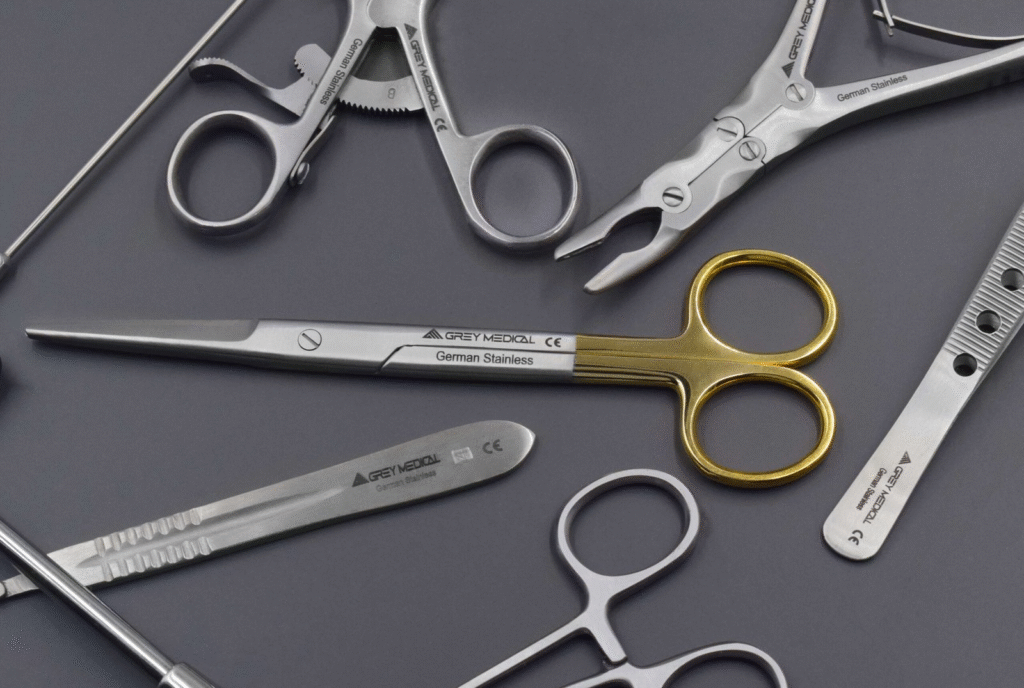
Surgical scissors may look like straightforward instruments, but in an operating room they are anything but ordinary. They are designed with precision in mind, helping surgeons perform delicate procedures with accuracy and care. Whether dissecting tissue, cutting sutures, or navigating complex anatomical structures, the right scissors make a significant difference in both efficiency and patient safety.
Because every type of surgical scissor serves a distinct purpose, understanding their differences is critical. Knowing how to select, use, and maintain them ensures they remain effective tools that support the highest standards of care. This guide explores the most common types of surgical scissors, their applications across specialties, and the best practices for keeping them in optimal condition.
Exploring the Range: Types of Surgical Scissors
Metzenbaum Scissors: Precision for Delicate Tissue
Metzenbaum scissors are a mainstay in procedures that involve fine tissue. Their long handles and shorter, tapered blades give surgeons the control needed to navigate delicate areas such as the abdomen or thorax. These scissors are not just used for cutting—they are equally valuable for blunt dissection, where the blades gently separate tissue layers without unnecessary trauma.
Their design also makes them comfortable to use in confined surgical spaces. Curved or straight tips add further versatility, allowing surgeons to adapt to the needs of different procedures. When chosen correctly, Metzenbaum scissors help minimize tissue damage, speed recovery, and improve patient outcomes.
Mayo Scissors: Built for Strength
When a procedure requires cutting through thick or fibrous tissue, Mayo scissors are the tool of choice. With their sturdy build and broader blades, they are well-suited for heavy-duty tasks like trimming fascia or managing sutures in orthopedic and abdominal surgeries.
Mayo scissors are available in both straight and curved designs. Straight blades are often used for cutting materials such as sutures, while curved blades allow access to deeper or more complex areas. Their ergonomic construction reduces hand fatigue, making them reliable for long, demanding surgeries.
Fine-Tip Scissors: Mastering Detail
Fine-tip scissors are crafted for precision work where even the slightest misstep could cause complications. With slim, pointed blades, they excel in fields such as plastic surgery and ophthalmology. These scissors handle the smallest details, whether trimming delicate tissue around the eye or managing microsurgical tasks.
In many specialties, fine-tip scissors are seen as an extension of the surgeon’s hand. Some models feature enhanced materials like tungsten carbide, which improves durability and keeps edges sharper for longer. The key to their effectiveness lies in steady technique and a thorough understanding of the anatomy being addressed.
Choosing the Right Scissors for the Task
Matching Tools to Specialties
Different surgical specialties require different tools. Orthopedic surgeons, for example, need sturdy scissors like Mayo to manage dense tissue, while pediatric surgeons prefer lighter instruments that minimize trauma for smaller patients. Microsurgeons rely heavily on fine-tip scissors to navigate complex structures like nerves and blood vessels.
By aligning the choice of scissors with the unique demands of each field, surgeons not only improve precision but also reduce the length of procedures and lower the risk of complications.
Grip and Control: Why Design Matters
The way scissors feel in the hand matters just as much as their cutting ability. Modern designs often feature lightweight materials like titanium to reduce fatigue, as well as ergonomic handles that fit comfortably during prolonged use.
Some designs include finger rings or locking mechanisms for added stability. These small details can dramatically improve control, ensuring that each cut is both accurate and safe.
Tips for Effective Use
Even the best scissors require skill to maximize their potential. Surgeons often practice with tissue models to refine their technique and develop muscle memory. Approaching cuts with the proper angle allows the instrument to do the work, reducing unnecessary force and minimizing trauma.
Maintaining an organized operating setup also matters. When tools are placed where they can be reached quickly, surgeons remain focused on precision rather than on searching for instruments mid-procedure.
Care and Maintenance: Keeping Surgical Scissors Reliable
Cleaning and Sterilization
Thorough cleaning is the foundation of safe instrument use. Scissors should be rinsed immediately after a procedure to prevent debris from hardening. A gentle scrub with appropriate cleaning agents, followed by ultrasonic cleaning, helps remove residue without damaging the blades.
Sterilization is the next step, often carried out through autoclaving or ethylene oxide treatment. Following the manufacturer’s guidelines is critical to avoid weakening the blades or damaging the material. Regular inspections for wear, rust, or misalignment ensure scissors remain safe and functional.
Sharpening for Longevity
Dull scissors compromise precision and can increase tissue trauma. Regular sharpening by skilled technicians restores their effectiveness. Techniques vary depending on blade shape, whether convex, concave, or flat. Professional maintenance ensures blades keep their intended angle, extending their lifespan and reducing the need for frequent replacements.
Proper Storage
How scissors are stored is just as important as how they are cleaned. Instruments should be placed in protective trays or pouches that prevent scratches and contamination. Storing them in a dry, sterile environment keeps them ready for use. Clear labeling and organization also help surgical teams locate the right scissors quickly during procedures.
Looking Ahead: The Future of Surgical Scissors
Advances in medical technology are reshaping even traditional tools like scissors. Some newer models integrate sensors that provide real-time feedback on pressure, helping surgeons avoid tissue damage. Robotic-assisted surgical systems are also making use of precision scissors that enhance dexterity and control during minimally invasive operations.
Sustainability is another growing focus. Manufacturers are experimenting with recyclable materials and eco-conscious production methods to reduce environmental impact while maintaining high performance standards.
Patient safety continues to drive innovation as well. Ergonomically improved designs reduce surgeon fatigue, while personalized tools tailored to hand size and grip style are becoming more common. Together, these developments point toward a future where surgical scissors are not only more precise but also smarter and more sustainable.
Final Thoughts
Surgical scissors may be small compared to other instruments in an operating room, but their role is anything but minor. Each type is carefully designed to meet the demands of specific procedures, making the choice of scissors just as important as the surgeon’s technique. When paired with proper maintenance and thoughtful use, these instruments help create safer surgeries and better outcomes for patients.
By understanding their differences, caring for them properly, and embracing new advancements, surgical teams can ensure that these essential tools continue to deliver the precision and reliability that modern medicine demands.


